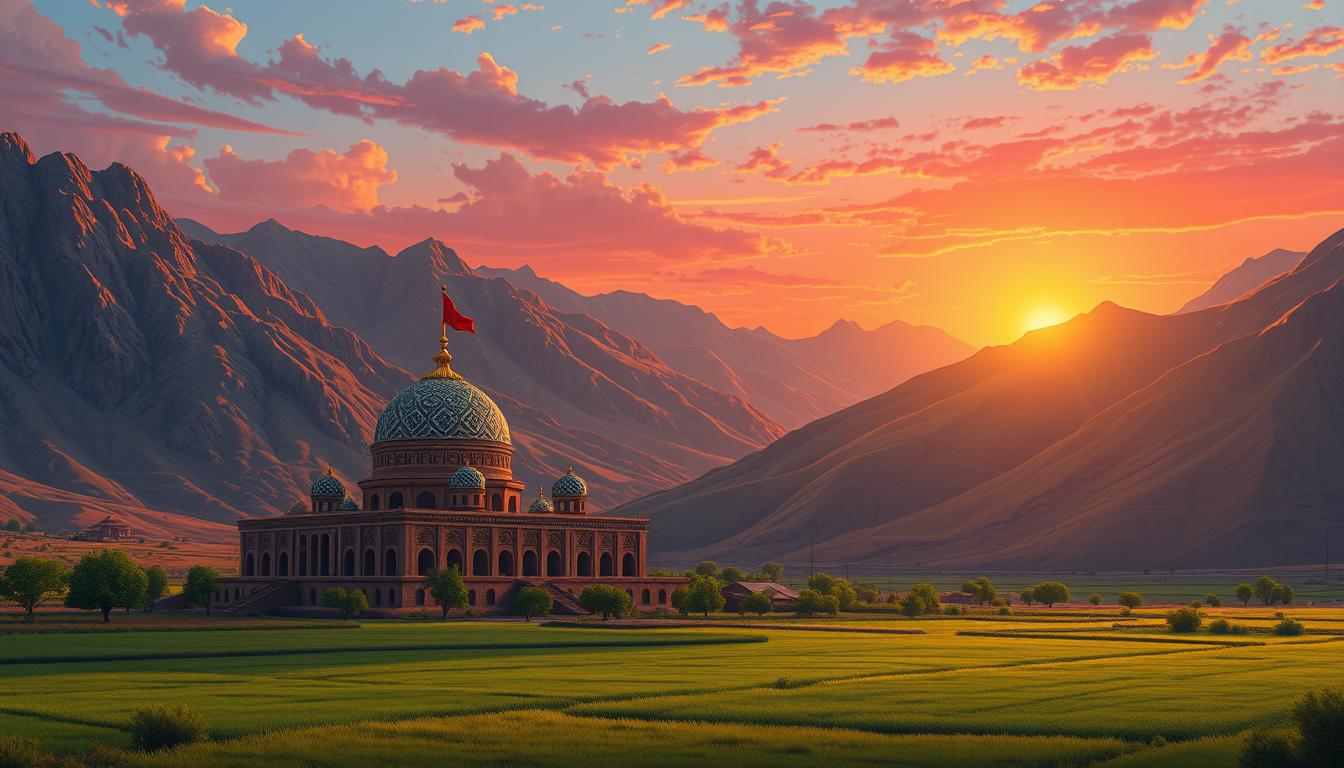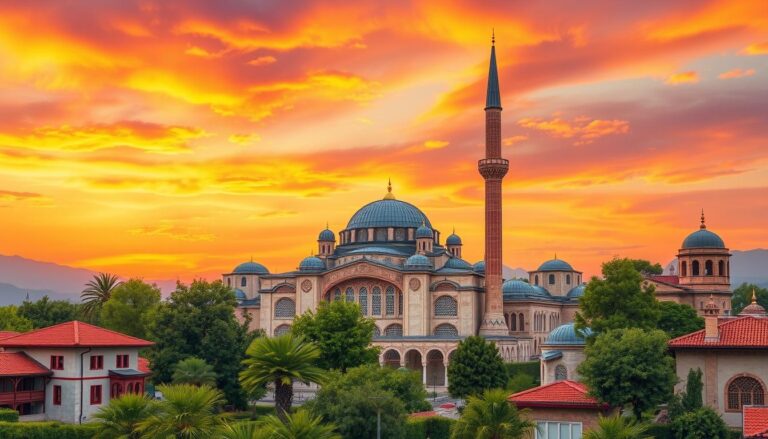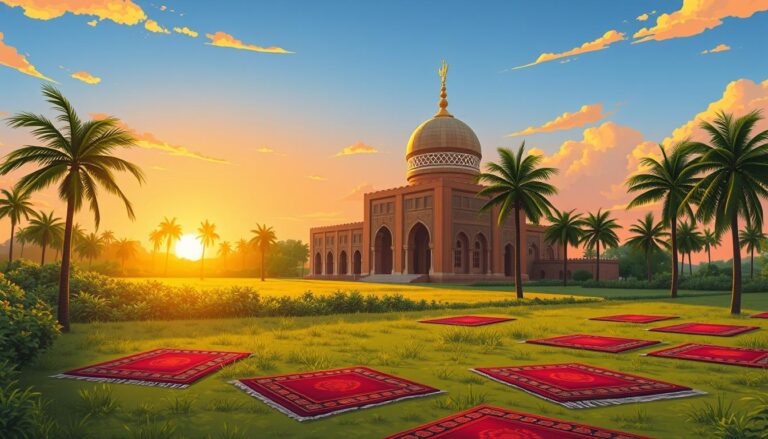Islam in Afghanistan
Islam is the main religion in Afghanistan, with about 99.7% of people following it. Sunni Islam is the biggest group, followed by Shia Islam. Islam came to Afghanistan with the Arab conquest from the 7th to the 10th centuries.
It replaced Zoroastrianism and Buddhism as the main religion. Islam deeply affects Afghan identity, customs, and social structure, especially in rural areas. The role of Islam in Afghan politics and state affairs has changed over time.
About 85% of Afghan Muslims are Sunni, and 10% are Shia. The rest belong to other religions. During the Islamic Golden Age, Afghanistan was a major center of learning, after Baghdad.
Institutions like the Friday Mosque of Herat, built in the 12th century, were key in the region’s culture and religion.
Origins and Early History
The Muslim conquests of Afghanistan started with the Arab conquests in Afghanistan and the spread of Islam in Afghanistan. Arab Muslims moved east to Khorasan, Sistan, and Transoxiana. By 642 AD, after the Battle of Nahāvand, Arabs controlled most Sasanian lands, except parts of Afghanistan and Makran.
The Rashidun Caliphate, Umayyad Caliphate, and Abbasid Caliphate claimed to rule over local leaders like the Zunbils and Kabul Shahis. In 711, Qutayba ibn Muslim made them pay tribute. But, the Arabs’ strict rule caused many local uprisings. By the end of the first century of the Hijri calendar, the Islamic conquest’s border became stable.
“The harshness of Arab rule led to numerous local rebellions, and the frontier of the Islamic conquest became more or less stationary by the end of the first century of the Hijri calendar.”
This time also saw the growth of powerful Islamic dynasties in Afghanistan. They set the stage for the region’s deep cultural and religious heritage. The early Islamic history of Afghanistan is both captivating and not well understood.
Consolidation and Golden Age
Afghanistan’s Islamic history saw a big change under the Ghaznavid and Ghurid dynasties. These Muslim empires were key in spreading Islam across the area. They brought about the Islamic Golden Age in Afghanistan.
The Ghaznavid dynasty started in the 10th century and loved Islamic learning. They made Afghanistan a major center of Islamic scholarship, second only to Baghdad. The Ghurids, who came after, also supported Islamic education. They built the famous Friday Mosque of Herat, one of the oldest mosques in the country.
“Afghanistan’s Islamic history during the Ghaznavid and Ghurid dynasties was a period of unparalleled cultural and intellectual growth, cementing its place as a hub of the Islamic Golden Age.”
The Ghaznavid dynasty and Ghurid dynasty were crucial in spreading Islam in Afghanistan. Their support for Islamic learning made Afghanistan a center of scholarship, rivaling Baghdad.
Mongol Invasion and Recovery
The 13th century saw a devastating Mongol invasion in Afghanistan. The Mongol army, with over 129,000 soldiers, destroyed the Khwarezmid Empire. This left the region in ruins. But, the Timurid and Safavid dynasties slowly rebuilt and recovered the area.
Devastation and Rebuilding
The Mongol conquest of Afghanistan was brutal. Cities like Bukhara faced repeated violence and destruction. The Khwarezmian army, with up to 400,000 soldiers, was no match for the Mongols’ advanced technology.
After the Mongols, the region was left devastated. There was widespread loss of life and damage to buildings. But, the Afghan people showed great resilience.
Under the Timurid and Safavid rule, rebuilding started. Bukhara began to flourish again by the 1230s. The Naqshbandiya order also grew, with leaders like Moḥammad Pārsā contributing to the cultural revival.
The Mongol invasion opened the door for the Timurids and Safavids to grow their power in Afghanistan. This led to a new era of Islamic learning and cultural growth.
“The city was repeatedly devastated by internal feuding, wars, and rebellions throughout the century after the Mongol conquest, with notable events such as a popular uprising in 636/1238-39, a massacre of 5,000 men in 662/1263, and the sacking of the city in 671/1273 and 716/1316.”
Shia and Sunni Influences
Afghanistan’s religious scene is mostly Sunni Islam, with about 85% of people following Hanafi or Deobandi schools. But, there’s also a big Shia Muslim minority, making up 10-15% of the population.
The Shia influence grew in the 16th century with the Safavid dynasty of Persia (now Iran) trying to expand its reach. This led to fights with the Sunni Mughal Empire over Afghanistan. Despite these battles, Sunni Islam is still the main religion in the country.
The Shia Muslims in Afghanistan mostly belong to the Twelver branch, with a few following Ismailism. They often come from ethnic minority groups, like the Hazaras. These groups have faced a lot of discrimination and violence in Afghanistan’s history.
“Sunni Islam (Hanafi/Deobandi) is the dominant denomination, with around 85% of the population following this branch. Shia Islam, primarily the Twelver branch, accounts for around 10% of the population, with a smaller number following Ismailism.”
Even though Sunni Islam is more common, there have been times of tension and fights between Shia and Sunni groups. The power struggles in the region, with countries like Iran and Pakistan, can make these problems worse. This could hurt Afghanistan’s already fragile peace.
As Afghanistan tries to find its way through its complex religious and political world, the balance between Sunni and Shia is key. It affects the country’s social and cultural life deeply.
Islam in Afghanistan
Islam deeply influences Afghan society, affecting politics, social life, and culture. Most Afghans, between 80-99.7%, follow Islam. The majority are Sunni Muslims, with a notable Shia Muslim minority.
Islamic customs and traditions are a big part of Afghan life. They mix with tribal codes and old beliefs. In rural areas, mosques and madrasas are key for education, even in refugee camps.
- Approximately 80% of the Afghan population is Sunni Muslim, while 19% are Shia Muslim.
- The Hanafi school of Sunni Islam is the predominant sect, with Shi’a Muslims primarily belonging to the Twelver denomination.
- Pashtunwali, the tribal ethical code of the Pashtuns, is heavily influenced by Islamic principles and practices.
- Pre-Islamic belief systems, such as Zoroastrianism, Buddhism, and Hinduism, have also significantly influenced Afghan cultural and religious traditions.
Islam ties Afghans together, influencing personal and political choices. The country’s Islamic heritage and faith in daily life shape its unique identity.
“Islam is not just a religion in Afghanistan, but a way of life that permeates every aspect of society.”
The role of Islam in Afghan society is clear. It deeply affects the country’s culture, traditions, and social structures.
Religious Education and Madrasas
In Afghanistan, Islamic education at madrasas and mosques has become key. These places are vital for learning about Islam and training scholars. They shape the country’s religious and cultural views.
Importance of Islamic Learning
Islamic learning is a big part of Afghan life. It has been important for centuries. The Taliban’s Deputy Minister of Education says 339,950 students are in madrasas, with 95,662 girls, as of August 2023.
In rural madrasas, students learn more than just religion. They study math, science, and languages like Arabic and Pashto. The Taliban now focus more on Islamic teachings, like Jihad.
“Madrassas help provide shelter, food, and clothing to students who attend, making them a vital resource for many families.”
Madrassas grew because the Afghan government couldn’t fund education in rural areas. Private donors help them, but they face challenges now.
But, madrasas have been criticized for not teaching critical thinking. Still, for many Afghan students, madrasas are their only chance to learn.
Political Influences and Reforms
The role of Islam in Afghan politics has changed over time. King Abdur Rahman Khan (1880-1901) was the first to use Islam to build the state. He made sure all laws followed Shariah law and put Shariah above other laws. Later rulers kept these policies but also wanted to show Islam and modernization could go together.
But, the role of religion in government started to lessen. The 1931 and 1964 constitutions made Hanafi Shariah the state religion. The 1977 constitution said Islam was Afghanistan’s religion, but didn’t say which school. This move towards secularization in Afghanistan was not welcomed by everyone, as some wanted more Islamic influence.
The debate over Islam and politics in Afghanistan has never stopped. Different groups have their own ideas about how much religion should play in government. The Taliban’s strict Islamic laws have made things even more complicated. The country is trying to find a balance between religious and secular ideas.
“The Afghan struggle is not about the presence of Islam, but with a militancy that has hijacked religion.”
Looking ahead, the role of Islam in politics will be key in Afghanistan’s future. It will shape the country’s politics and society.
Islamic Extremism and Conflict
Afghanistan has faced a lot of conflict and extremism in recent years. Groups like the Taliban and Al-Qaeda have been big challenges. The Mujahideen, who fought against the Soviet occupation, later split into factions. Some of these factions became the Taliban in the 1990s.
The Rise of Taliban and Al-Qaeda
The Taliban followed a strict Islamic law and allied with Al-Qaeda. This led to the US invasion in 2001, which overthrew their rule. But, the conflict’s effects are still felt today, affecting Afghanistan’s security and stability.
Since the Taliban took power in August 2021, things have gotten worse for Afghan women and girls. There has been little action from the international community. The Taliban’s actions might face legal consequences in the International Criminal Court.
The Mujahideen, trained in the anti-Soviet war, have played a big role in today’s terrorism. Groups like secular Palestinians and countries like Iran and Saudi Arabia have backed terrorists for their own goals.
Sufi Traditions and Practices
Afghanistan is home to a rich Sufi heritage. Sufism, a mystical part of Islam, has shaped the country’s culture and spirituality. It has been present in Afghanistan for over 1,300 years.
Even though most Afghans are not direct followers, Sufism’s impact is still strong. It influences both city and rural life.
The Taliban’s rule from 1996 to 2001 was hard on Sufism. Many Sufis had to hide. Yet, the tradition has endured, thanks to figures like Khwaja Abdullah Ansari and Ahmed Gailani.
Sufi practices in Afghanistan vary. They include Qawwali music and the remembrance of God. Afghans also value Sufi shrines, seeing them as places for personal needs.
The Naqshbandi tariqa is a major Sufi order in Afghanistan. It has influenced the country’s spirituality. Sufi poetry and teachings were once common in madrasas, but changes came with the Soviet occupation.
Despite obstacles, Sufism in Afghanistan remains strong. The community is working to rebuild Sufi centers, like the Khanaqah Pahlawan lodge in Kabul. Their efforts show the lasting impact of Sufism on Afghanistan’s Islamic heritage.
“Sufism in Afghanistan has a unique and profound history, reflecting the country’s rich spiritual and cultural diversity. Despite the challenges it has faced, the Sufi tradition continues to leave an indelible mark on the lives of many Afghans.”
Islamic Art and Architecture
Afghanistan is known for its stunning Islamic architecture. You can see mosques, shrines, and monuments all over the country. These buildings show the deep impact of Islamic culture and its changing styles over time.
Mosques and Monuments
The Friday Mosque of Herat is one of the oldest Islamic buildings in Afghanistan. It was built in the 12th century by the Ghurid dynasty. Its design, with a central iwan, is typical of Islamic architecture.
The Minaret of Jam is another important site. It was built in the 12th century by the Ghurid dynasty. This minaret is 62 meters tall and shows the mix of Persian and Islamic styles.
Afghanistan has many shrines and mausoleums that are key pilgrimage sites. The Khwaja Abdulla Shrine in Herat, built in the 15th century, is famous for its beautiful turquoise and black brickwork. It was inspired by Timurid architecture.
The Bagh-e-Babur in Kabul is a unique site. It was built around 1528 and has a mosque, a garden pavilion, and a queen’s palace. It shows the variety of influences on Islamic architecture in Afghanistan.
“Afghanistan’s architecture exhibits diverse and unique styles due to its historical connection to Central Asia, the Indian subcontinent, and the Iranian plateau.”
Afghanistan’s architecture is rich and varied. It includes the famous Ghaznavid and Ghurid buildings. The Shah do Shamshira Mosque in Kabul is a great example of Afghan baroque architecture. These buildings highlight the country’s cultural heritage over the centuries.
Islamic Festivals and Celebrations
The Islamic calendar is a big part of Afghanistan’s culture and traditions. Major festivals like Eid al-Fitr and Eid al-Adha are celebrated across the country.
Eid al-Fitr, or the “sweet Eid,” ends the holy month of Ramadan. In 2024, it started on Tuesday, April 9th evening. Families enjoy treats like Goash-E-Feel and celebrate, believing “Eid belongs to the children.”
The Prophet Muhammad’s birthday, known as Mawlid or Mawlid al-Nabi, is another big event. It’s celebrated with religious gatherings, Quran recitations, and traditional sweets.
The Islamic New Year, Nowruz, is also celebrated. It falls between March 19th and 21st. Celebrations last two weeks, ending on March 20th in some years. Families buy new clothes, host parties, and enjoy traditional foods like Samanak.
These Islamic festivals in Afghanistan, such as Eid celebrations and Mawlid celebrations, show the Afghan people’s strong Islamic faith. They also bring families and communities closer together. These celebrations highlight Afghanistan’s rich cultural heritage and traditions.
Conclusion
Islam has shaped Afghanistan for centuries, influencing its culture, identity, and politics deeply. From Arab conquests to the golden age of Islamic rule, Islam has been central. It has endured through conflict and extremism, remaining a core part of Afghan society.
The role of Islam in Afghan politics has changed over time. Yet, it still greatly impacts education, law, and cultural traditions. This shows Islam’s lasting influence in the country.
As Afghanistan faces its challenges, Islam’s role will be key in shaping its future. The Afghan people’s Muslim identity is deeply rooted in Islam’s history and values. This identity will guide the nation’s path forward.
The struggle for religious freedom and the impact of Islamic principles are crucial topics. They highlight Islam’s complex role in Afghan society and politics. Understanding this is essential for the country’s progress.
It’s vital for policymakers, scholars, and the world to grasp Islam’s influence in Afghanistan. Recognizing its impact on the nation’s past, present, and future is crucial. This will help Afghanistan move forward effectively.
Source Links
- Islam in Afghanistan
- Muslim conquests of Afghanistan
- Afghanistan – Muslim Dynasties, History, Culture
- Introduction. Afghanistan’s Islam: A History and Its Scholarship
- Dar al-Islam from 1200-1450 | AP World History: Modern Class Notes | Fiveable
- Welcome to Encyclopaedia Iranica
- Mongol Conquest of Khwarezmia
- The Sunni-Shia Divide
- Religion in Afghanistan
- Why have Afghanistan’s Shias been targeted now?
- Afghan – Religion
- Afghanistan’s madrasa system under the Taliban
- AP PHOTOS: Life in a madrassa as Afghanistan enters new era
- The Taliban’s Weaponization of Education
- The Taliban vs. Global Islam: Politics, Power, and the Public in Afghanistan
- A historical timeline of Afghanistan
- The Growing Threat of the Islamic State in Afghanistan and South Asia
- The Evolution Of Islamic Terrorism – An Overview | Target America | FRONTLINE
- Sufism in Afghanistan
- Sufi transitions: between mullahs and Sufis in Afghanistan | Aeon Essays
- Architecture of Afghanistan
- Architecture of Afghanistan
- Eid al-Fitr: Your Questions Answered
- Nowruz in Afghanistan: Everything You Need to Know
- Afghanistan – United States Department of State
- The Taliban, radical Islam and Afghanistan
- How Religious Diplomacy and Pan-Islamic Organizations Can Help Stabilize Afghanistan







